
A surprisingly large number of the low back cases I see each week are because the patient’s back is simply not strong enough to support them during stressful activities. Very small percentages are due to actual injuries like slips and falls or auto accidents. About 30% are not even a back problem, but a gut inflammation problem that is referring to the back causing the back muscles to spasm. The majority of the time the person has simply done more than the stabilizing muscles could handle.
The obvious answer to preventing these types of back problems is to strengthen and retrain the back muscles that stabilize the spine. We are talking here about core stabilization training, but every gym trainer I talk to or read about does not seem to know what the spine stabilizer muscles are. Everyone is focused on the abdominal muscles, which are not the core stabilizer muscles of the back. A group of muscles that lie right up against the spine in the back, called the multifidi muscles, are in fact the core stabilizer muscles for the spine. But these muscles are not sexy and working them out is boring, so they get ignored.
True stabilizer muscles turn off when you move the area they are working in. They are for stability – that means locking an area down and not letting it move. So doing crunches is worthless for building stability of the spine – sorry. Crunches are good for building a six-pack, but that is pretty much it.

Yoga, as practiced in most studios, is also not good for back stabilization. In fact one of the great secrets of the yoga instructor world is how many back problems the instructors have. The reason for this is that most yoga postures emphasize flexion postures that stretch open the spinal joints. While this may feel good and help relieve muscle tension in the spine, it is the opposite of what the spine actually needs. The spine is not supposed to be really flexible. The spine is supposed to be strong and solid. It is supposed to be the core base from which you anchor your arms and legs. It is the arms and legs that are supposed to be flexible.
There is a yoga form that does strengthen the spine called Yin Yoga. It focuses on back extension postures and on holding still for long periods. It will be modifications of some of these postures that I will be focusing on today.
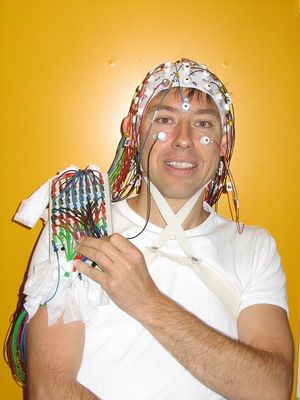
Modern researchers have been sticking electrode needles into people’s backs for many years now to measure just what exercises are the most beneficial and how best to apply them. One interesting finding that has not made it into the yin yoga world yet is that the maximum benefit gained by a muscle due to a contraction exercise is gained within 8 seconds. No greater benefit is gained by holding a contraction for 30 seconds or a minute. It is a lot more work to hold longer, but it is wasted effort as no greater gain in strength happens. So when doing a held contraction to build muscle strength, I suggest you hold for only 8 seconds.
Another useful finding about exercise is that the same benefit is gained by spacing out the contractions, as doing them closely spaced together. What that means in practical terms is that doing 10 muscle contractions in a row at the gym is no better than doing 1 contraction at 10 different times during the day. So the whole working out hard and getting all sweaty and exhausted at the gym scenario is completely unnecessary. It is actually better to work out a little bit all day long and allow plenty of rest between muscle workouts.
There is one basic muscle contraction for strengthening the spine – the mild back extension. It can be done in many different positions, but the muscle you want to contract is the one right next to the bumps running up 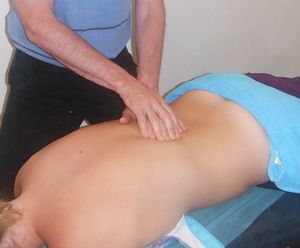 the middle of your back on both sides. This muscle starts at the pelvis and extends clear up to the base of your scull. This is not the big back muscle that goes from the top of your hip bones over to your spine (quadratus lumborum). It is the muscle just in that one inch on either side of your spine. This is important because you need to feel this muscle getting tighter when doing the exercises I am about to show you.
the middle of your back on both sides. This muscle starts at the pelvis and extends clear up to the base of your scull. This is not the big back muscle that goes from the top of your hip bones over to your spine (quadratus lumborum). It is the muscle just in that one inch on either side of your spine. This is important because you need to feel this muscle getting tighter when doing the exercises I am about to show you.
I want to start with really easy ways of exercising this primary stabilizer muscle of the spine – the multifidi.
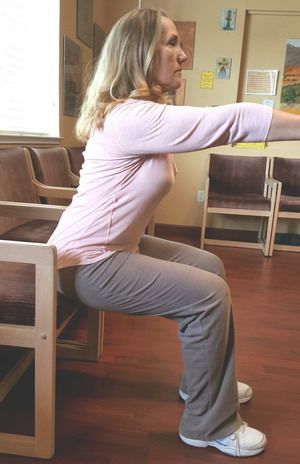
1. Scoot to the edge of your chair and bend forward at the waist as far as you can – like you want to pick something up from the floor. Now raise your head and upper chest up while leaving the mid and lower back still flexed forward. The back will arch a tiny bit and you should feel the muscles in close to the spine tightening. Hold this position for 8 seconds. Repeat this move every hour if you are sitting for long periods of time. You can enhance this move by extending your arms like you are flying Superman style.
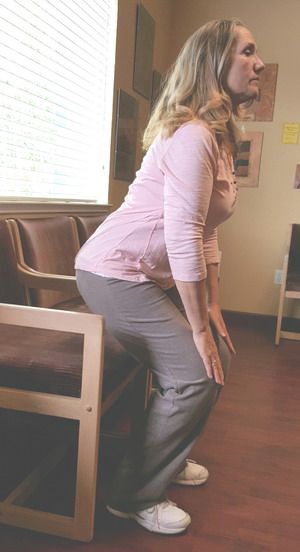
2. Every time you go to sit down, pause a few inches above the seat for 8 seconds, then sit down. The trick here is to pause with your head up and your low back arched forward. Your butt just hovers over the chair seat for the 8 seconds. Again, extending your arms out can enhance this move. Increasing the challenge even more is achieved by moving the hands around slowly to produce different pulls and stresses on the low back stabilizers. But save the fancy stuff till after the basic is easy.
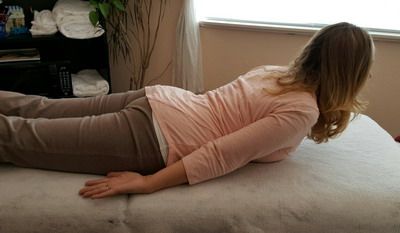
3. Start your day before you get out of bed by rolling onto your stomach and lifting your head and if possible upper shoulders and arms for a count of eight.

4. If you are at home or around a couch or bed, bend your knees and rest them on the edge of the bed or couch. Stick your butt back and arch your low back forward. Hold for that count of eight. You should really feel those muscles up tight against the spine contracting. Advanced move for this is again the superman position and moving the arms around. Keep the head up high looking straight ahead, not down.
All these exercises are achievable by even the most out of shape among you. They do not require getting down on the floor or even particularly good balance. As you get better with these exercises, I recommend advancing to the Foundation program as described in the book Foundation by Eric Goodman.
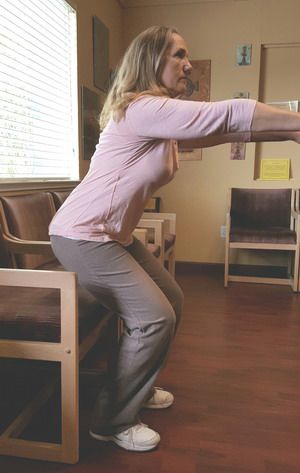
The key to success here is to get started. Pick the easiest exercise for you and just do it several times every day. This is the greatest insurance policy you can obtain for your low back. There are several forms of the multifidi exercise, so you can engage this stabilizer muscle anywhere any time. Just do it and feel the improvement in your low back. The exercises are easy. They only take 8 seconds to do several times a day. There are no excuses like “my knees hurt” or “I can’t get down on the floor” or “I am just too tired” that you can use with these exercises. Anyone can do them anytime. They will strengthen your spine and help it hold together.
